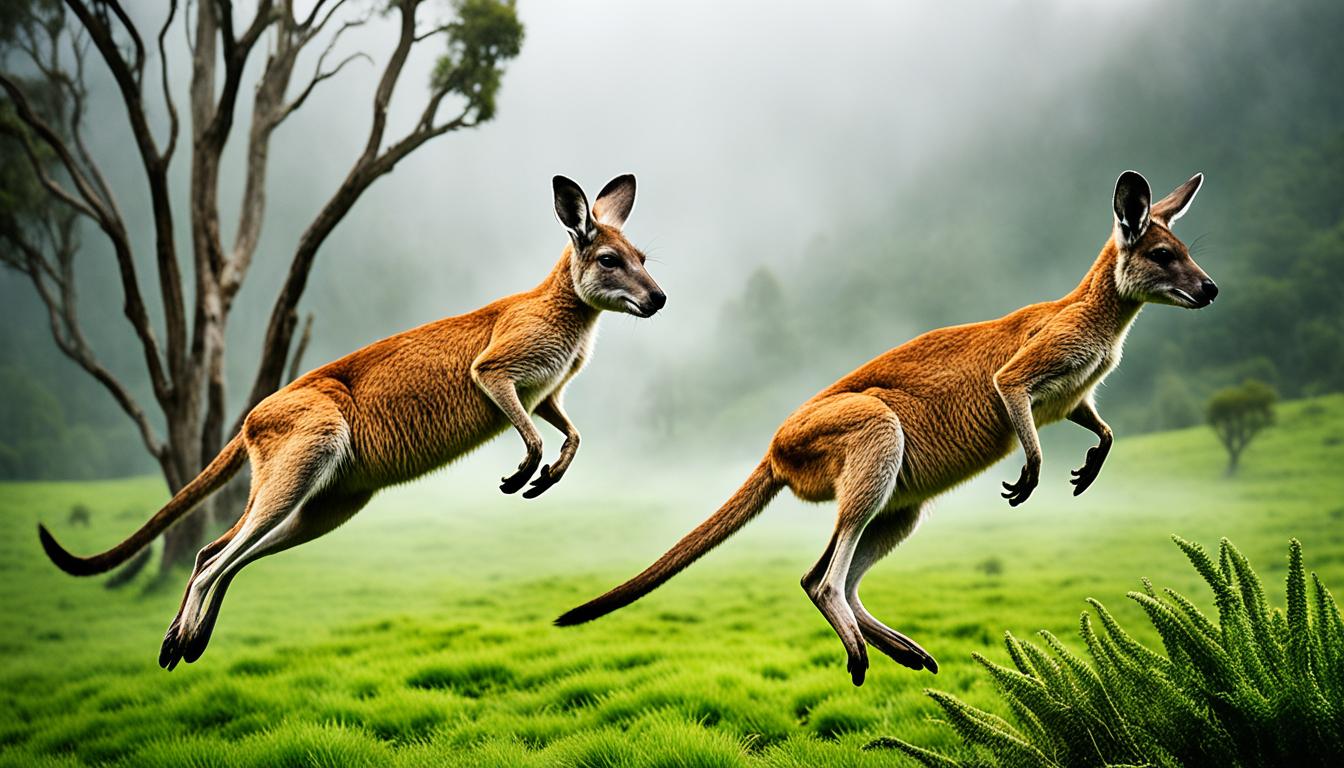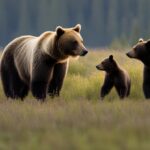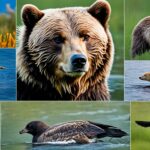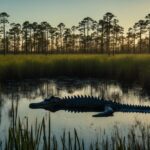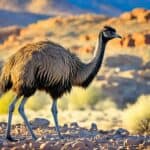Have you ever thought about seeing a kangaroo in the American wild? While many think kangaroos only live in Australia, some reports are making people wonder. This part looks at these reports and the challenges they bring to what we knew about these animals.
Kangaroos are famous for how they jump and their strong legs in the wild Australian lands. But, stories of “phantom kangaroos” in North America have caught people’s attention. Are these just stories or could there be something more? Let’s learn more about the habitat of American kangaroos and the sightings from over a hundred years.
The Presence of Wild Kangaroos in North America
Stories about wild kangaroos roaming North America have captivated many for years. These tales go back over a hundred years. They tell of kangaroos appearing in places far from their native Australia.
Historical Kangaroo Sightings
In 1899, a kangaroo was seen in a Wisconsin yard, marking one of the first known US kangaroo sightings. Since then, similar reports have popped up across the Midwest, puzzling and fascinating people. In Chicago, a kangaroo made headlines for outrunning police, becoming a part of local folklore and news.
Modern Reports and Evidence
Even in recent times, stories about kangaroos in North America keep emerging. Witnesses claim to have seen them in the countryside and even backyards. These modern stories add to the mystery, without solid proof of a kangaroo population in America.
Wild Kangaroo Sightings in the United States
In the United States’ history, many have seen wild kangaroos. These sightings have caught a lot of attention, sparking debates. The reports cover past historical claims to modern sightings, adding mystery to the story.
Notable Reports in History
The late 1890s brought early accounts of kangaroos in the U.S. Various newspapers shared sightings across states. They suggested these animals might be escapees from zoos or circuses. Yet, not all claims had solid evidence, leaving people to guess.
In the 1950s, the Midwest had multiple reporting of kangaroo-like creatures. A famous 1957 Indiana report told of an animal leaping across the land. Locals thought it looked like a kangaroo. Such stories fueled both curiosity and disbelief.
Recent Sightings and Locations
In recent times, wild kangaroo sightings have expanded across the U.S. Places like New York, Minnesota, and Arizona have made headlines. These reports had many witnesses, catching people’s attention.
One dramatic event happened in 2013 in Texas. A driver filmed a kangaroo hopping along a busy road. While this video wasn’t a clear proof, it updated the tale of kangaroos in America.
A table below showcases some significant and recent kangaroo sightings across the U.S. This gives an insight into where and when these encounters happened.
| Year | Location | Details |
|---|---|---|
| 1899 | Wisconsin | First documented sighting of a kangaroo-like creature. |
| 1957 | Indiana | Multiple reports of a kangaroo leaping across fields. |
| 2013 | Texas | Video footage of a kangaroo on a highway. |
| 2020 | New York | Several sightings in suburban areas. |
Phantom Kangaroos: Myth or Reality?
The phenomenon of phantom kangaroos has intrigued cryptozoologists and skeptics for decades. The USA is often a hot spot for discussions. Are these kangaroos real or just a product of wild imaginations? Let’s look at the history and science to find out if they are myth or reality.
Origin of the Phantom Kangaroo Legend
Many stories of phantom kangaroos come from old tales. They first came into the limelight in the 19th century. People told stories of seeing them around the USA. These accounts often linked back to escaped zoo animals or pets from faraway places. In 1934, a kangaroo sighting in Tennessee made headlines. Stories like this in the press helped keep the legend alive.
Scientific Perspective on Phantom Kangaroo Sightings
Scientists offer various explanations for kangaroo sightings in the USA. They say sometimes people mistake other animals for kangaroos, like deer or large hares. The people could have seen kangaroos that escaped from farms or private collections. These reasons make sense for some cases. But not all stories can be clearly explained. That mystery keeps people intrigued and talking about phantom kangaroos.
Project Sage Hopper: Introducing Kangaroos to Wyoming
Project Sage Hopper brings Antilopine Kangaroos to Wyoming. It’s a big project from the Wyoming Wild Game Department and the Wyoming Migration Initiative. Their goal is to add to the wildlife variety and give people more chances to see and potentially hunt these animals.
The project looks closely at how kangaroos fit in Wyoming. Researchers study what they eat, how they act, and their impact on local wildlife. The idea is to help them thrive and offer a new experience to those who visit or live in the area.
Introducing kangaroos is also about making Wyoming a more exciting place to visit. It aims to draw in nature lovers and increase the state’s income from tourism. There’s also talk about having limited hunts, which could help the economy grow more.
Studies constantly check on the kangaroos’ health and where they go. This data helps experts understand how well they’re doing in their new home. The project is a big step towards more diverse wildlife in the area.
| Aspect | Details |
|---|---|
| Project Name | Project Sage Hopper |
| Lead Organizations | Wyoming Wild Game Department and Wyoming Migration Initiative |
| Primary Objective | American kangaroo introduction |
| Goals | Wildlife viewing, potential hunting avenues, ecological adaptation |
| Key Species | Antilopine Kangaroos |
Challenges in Establishing Kangaroo Populations in the USA
The idea of bringing kangaroos to the U.S. seems cool, but it faces many hurdles.>These include finding a place that’s right for them and handling issues with people.
Environmental Suitability
Before we can bring kangaroos over, we need to think. Can they live well here? Australia’s unique environment, with its certain plants and predators, fits kangaroos perfectly.
America offers very different landscapes. From Arizona’s deserts to the Pacific Northwest’s forests, it’s a big change from the Aussie outback. Adjusting to these new places might be hard for kangaroos.
Human-Wildlife Interactions
Kangaroos and people need to get along, but it might not be easy. In Australia, they sometimes clash with farming, causing issues like accidents and damaged crops.
Similar problems could happen in the U.S. This might involve farmers and others, each with their own views on kangaroos. We need good plans to avoid trouble.
- Environmental Adaptation: Ensuring kangaroos can thrive in diverse American climates.
- Human Conflict: Mitigating potential issues with farmers and urban regions.
- Ecosystem Impact: Assessing the effect on local flora and fauna.
To sum up, bringing kangaroos to the U.S. is filled with many hard choices. We need to think carefully about each challenge to make it work.
Kangaroo Habitats: Could the US Provide a Suitable Environment?
Could the USA welcome kangaroos? We need to check if the climate and land suit them. The US has very different places, like deserts and forests, which could be home to kangaroos.
Climate and Terrain Comparisons
Kangaroos live in mainly dry areas in Australia. They like open lands with few trees and handle hot and dry weather well. Places in the US, like the deserts in Arizona and Nevada, have similar conditions. The Midwest with its wide grasslands could also be a good place for them.

Potential Habitats Across Different States
Several states would work well for kangaroos. The Great Plains have lots of open space for them to roam and eat. States such as Texas and Oklahoma have the right weather and plenty of land. This makes them good candidates for kangaroo living. Places with mild winters, like Southern California and Florida, also have the right features for kangaroos.
For a better view, here’s a comparison table:
| State | Climate | Terrain |
|---|---|---|
| Arizona | Arid | Deserts, Plains |
| Texas | Semi-arid, Humid Subtropical | Grasslands, Rangelands |
| California | Mediterranean | Coastal, Valleys |
| Florida | Humid Subtropical | Wetlands, Forests |
| Nebraska | Continental | Great Plains |
These states have what kangaroos need to live well. Their presence would add more variety and life to the US natural settings.
The Impact of Introducing Non-Native Species
Bringing kangaroos to the USA means we must think about both nature and money. We have to carefully weigh the good and bad. It’s not just about how cool kangaroos are.
Ecological Concerns
Introducing kangaroos to the USA could really shake things up. They might take over, making it hard for local animals to live. They can even bring new diseases that others can’t fight. And, they could mess up plant and soil life, affecting everyone around.
Economic and Recreational Benefits
But wait, there’s a bright side. Kangaroos could bring a lot of tourists. Those who want to see something different in the USA. This can help local shops and parks a lot. It may even create new jobs and push for better care of nature.
Plus, it could be fun. People could take tours and learn how kangaroos live here. This could teach about nature and how to visit in a way that’s good for the Earth.
| Ecological Impact | Economic Benefit |
|---|---|
| Disruption of local ecosystems | Increased tourism revenue |
| Competition with native species | Job creation |
| Alteration of habitat | Enhanced conservation efforts |
| Potential for disease introduction | Eco-tourism development |
Are there wild kangaroos in the USA?
We’ve explored a fascinating topic: wild kangaroos in the USA. Our journey led us through historical records and recent sightings across North America. We also looked at the stories of phantom kangaroos and what science says about it all.
From kangaroo reports in Wisconsin back in the 1800s to newer stories, we found a mix of intriguing tales. These accounts spark our imagination.
Project Sage Hopper wants to bring kangaroos to Wyoming. While it’s ambitious, it shows hope for kangaroo growth. The project also faces hurdles like finding the right environment and handling human interactions.
This project makes us think about the effects of adding species to new areas. Even though the idea of wild kangaroos in the USA seems more myth than reality, it brings up important talks on how we manage wildlife and protect our environment.
FAQ
Are there wild kangaroos in the USA?
No, there isn’t proof of kangaroos living wild in the USA. Stories have been told of seeing them, called “phantom kangaroos,” over time.
Where have kangaroo sightings been reported in North America?
Reports from places like Wisconsin, Illinois, and Missouri exist. They date back to the late 1800s until more recently. Unfortunately, there’s no solid proof of these sightings.
What are “phantom kangaroos”?
“Phantom kangaroos” are where kangaroos are seen in places they don’t usually live, like in North America. These stories are part of an area of study called cryptozoology.
Has there been any official effort to introduce kangaroos to the USA?
There was a project called Sage Hopper by the Wyoming Wild Game Department. They aimed to introduce Antilopine Kangaroos in Wyoming for hunting and wildlife watching.
What are the challenges of establishing a kangaroo population in the USA?
It’s tough because you have to make sure the environment matches their needs. You also must watch out for any harm to local plants, animals, and people.
Could the US provide a suitable habitat for kangaroos?
To provide a good spot, it must fit the same conditions as in Australia. Some US places, like parts of the Southwest, offer similar living spaces.
What are the environmental impacts of introducing non-native species like kangaroos?
Bringing in new animals can hurt the local ones, change the area, and cause problems we didn’t expect. Yet, it may bring in money from visitors and people coming to see the animals.
Have there been any recent notable sightings of kangaroos in the US?
Some people say they’ve seen kangaroos, but these stories haven’t been proven true. Usually, these sightings turn out to be from pets that got loose instead of wild kangaroos.
How have experts responded to reports of wild kangaroos in the USA?
Experts are not quick to believe in these sightings. They think more likely, it’s a case of misidentifying animals or someone’s escaped pet, not real wild kangaroos.

